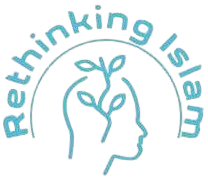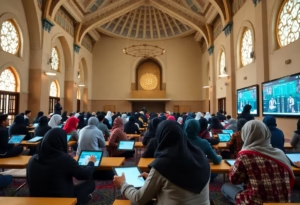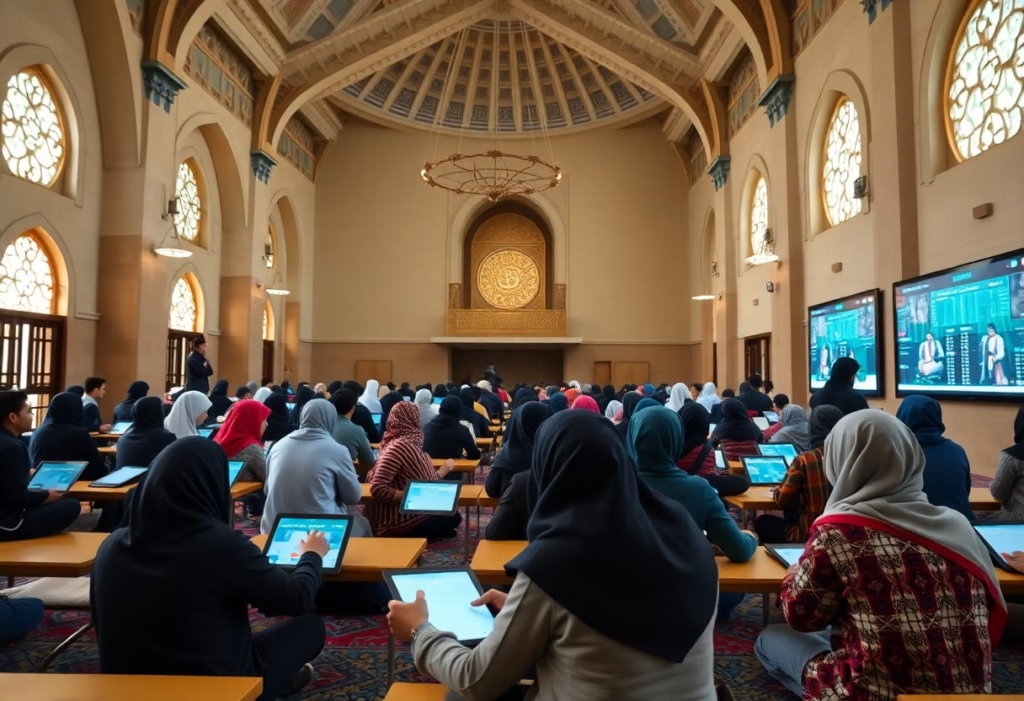Many education systems around the world are evolving, yet madrassahs often remain tethered to outdated practices. As you explore into the significance of these religious institutions, it is vital to consider their potential for promoting critical thinking and social integration. By reimagining their curricula, you can help transform madrassahs into centers of inclusive education that empowers students while respecting cultural values. This post will guide you through the pressing need for reform and the positive outcomes it can foster for individuals and communities alike.
Bridging Tradition and Modernity
Integrating traditional Islamic education with contemporary academic frameworks can foster an environment where students thrive. By emphasizing both religious teachings and relevant modern subjects, you can empower young minds to navigate today’s complex world while still retaining their cultural and spiritual roots. This dual approach opens pathways for students to engage with global issues, technology, and social sciences—skills which are necessary for the future workforce. Constructive partnerships between educators, community leaders, and policymakers can facilitate this transition, ensuring that madrassahs stay relevant and impactful.
The Historical Role of Madrassahs in Society
Madrassahs have historically served as educational hubs within Muslim communities, providing religious instruction alongside basic literacy and secular studies. Established as early as the 9th century, these institutions were pivotal in nurturing scholars like Al-Ghazali and Ibn Khaldun, who contributed to advancements in philosophy, science, and theology. By examining this legacy, you can appreciate how madrassahs shaped societal progress and intellectual discourse within various cultures.
Cultural Significance and Community Impact
The impact of madrassahs extends beyond education, influencing social cohesion and cultural identity. These institutions often act as community centers, where families gather for educational, religious, and cultural activities. In many instances, madrassahs provide vital services, such as meals and healthcare, to underserved populations. For instance, in regions facing poverty, some madrassahs have become lifelines, offering support networks that foster resilience and community solidarity.
Furthermore, madrassahs cultivate local traditions while promoting tolerance and interfaith dialogue. By hosting events that showcase cultural heritage, such as festivals and seminars, they invite diverse participation, knitting together different factions within the community. In countries like Indonesia and Malaysia, madrassahs actively contribute to societal harmony and social service, bridging gaps between various ethnic and religious groups. This cultural significance demonstrates the potential of madrassahs to play a transformative role in nurturing inclusive environments while retaining their core educational missions.
Curriculum Evolution: Adapting to Global Demands
The transformation of madrassah curricula is vital for preparing students for a rapidly changing world. By incorporating both foundational Islamic teachings and innovative subjects, you can ensure that your students are equipped with skills for global citizenship and adaptability. This evolution not only responds to local needs but also aligns with international educational standards, promoting a sense of unity and understanding in a diverse and interconnected society.
Integrating Contemporary Subjects
Incorporating subjects like mathematics, science, and technology into the madrassah curriculum enriches traditional teachings. You can introduce digital literacy courses and foreign languages, creating a more holistic educational experience. Programs like STEM (Science, Technology, Engineering, and Mathematics) will prepare students for careers in a tech-driven landscape, ensuring their relevance in today’s job market.
Emphasizing Critical Thinking and Problem Solving
Fostering critical thinking and problem-solving skills prepares your students to face complex challenges with confidence. By emphasizing analytical thinking, you help them develop a mindset geared towards inquiry and exploration. Engaging students in real-world scenarios, discussions, and collaborative projects cultivates their ability to generate solutions and think independently.
Critical thinking and problem-solving are imperative skills that go beyond rote memorization and traditional learning styles. For instance, integrating discussions on current global issues into the curriculum encourages students to analyze information from multiple perspectives. You might consider using case studies or simulations that challenge them to apply their knowledge in practical situations. Additionally, promoting a question-and-response approach in the classroom transforms passive learning into an interactive process, boosting student engagement and retention. This dynamic learning environment ultimately prepares you and your students for unforeseen challenges and opportunities in the global landscape.
The Technology Frontier: Digital Transformation in Madrassahs
Employing technology in madrassahs can unlock opportunities for modern education, blending traditional teachings with contemporary methodologies. Digital tools, when integrated effectively, enable a deeper learning experience, improving retention and engagement among students. By adopting software solutions and online resources, madrassahs can enhance curriculum delivery, making it more relevant and accessible to today’s generation. This transformation mandates an open mindset towards change and an embrace of innovative practices that can reshape the educational landscape in these institutions.
Leveraging E-Learning Platforms
E-learning platforms offer the potential for widespread educational reform within madrassahs. Utilizing online modules allows students to learn at their own pace, with access to a diverse range of subjects. This adaptability fosters a personalized educational experience, catering to individual learning styles and promoting mastery of important concepts. Furthermore, collaboration with international educators can provide madrassah students with exposure to a global curriculum, enriching their understanding and appreciation of various cultures.
Challenging Gender Gaps with Access to Technology
Closing the gender gap in education becomes achievable through targeted access to technology in madrassahs. By providing girls with tablets and internet connectivity, you break down long-standing barriers that prevent them from pursuing their studies. Enhanced online resources enable female students to explore academic interests outside traditional boundaries, nurturing their ambitions and skills. In regions where cultural constraints limit educational opportunities for girls, the digital realm can serve as a sanctuary for growth and empowerment, paving the way for future leaders.
Focusing on bridging the gender divide, several madrassahs have successfully integrated technology programs specifically designed for girls. Initiatives that offer training in coding and digital literacy have seen remarkable outcomes, with female students displaying greater confidence and decision-making capabilities. Various NGOs and community organizations have recognized this need, facilitating workshops that emphasize the importance of technology in education. As more girls gain access to digital platforms, the potential for broad social change increases, enhancing not just educational attainment but also the overall well-being of communities. Investing in these technology-driven initiatives yields a powerful ripple effect, transforming perceptions and realities for future generations.
Reimagining Educator Roles: From Instructors to Mentors
Transforming the role of educators in madrassahs involves shifting from traditional instructors to mentors who foster personal growth and intellectual curiosity. You play a key role in guiding students through not just academic content, but also emotional and social development. By cultivating relationships built on trust, you can encourage students to explore their passions, instill critical thinking skills, and promote lifelong learning, thus shaping more well-rounded individuals who are equipped to navigate the complexities of the 21st century.
The Shift Toward Holistic Education
Holistic education emphasizes the development of the whole person—emotionally, socially, and ethically—beyond just academic achievement. In this approach, you can create an environment where values-based learning and character development are intertwined with curricula. By integrating life skills and personal insights into your teaching methods, you foster a sense of community and purpose, leading to an enriched educational experience that prepares students for real-world challenges.
Essential Skills for Educators in Modern Contexts
Adapting to a modern educational landscape demands a new skill set for educators. You need to focus on collaboration, conflict resolution, and technological proficiency. As educators, enhancing communication skills and cultural competency becomes important to effectively engage with diverse learners. By honing these skills, you can facilitate a more inclusive and supportive learning environment that caters to the varied needs of your students.
In today’s rapidly evolving society, familiarity with digital tools isn’t optional; it’s a necessity. You must integrate technology in ways that enhance learning and provide students with accessible resources. Skills in data literacy can also help you track individual progress and adapt lessons to fit different learning styles. Furthermore, fostering emotional intelligence allows you to connect more deeply with students, enabling you to support their unique challenges and aspirations effectively. With these important skills, you can pave the way for a dynamic and relevant learning experience.
Ensuring Sustainability: Funding and Support Models
Building a sustainable future for madrassahs in the 21st century depends on innovative funding and support models. Diversifying funding sources beyond traditional avenues is crucial. This may include establishing endowments, seeking government grants, or collaborating with international organizations dedicated to educational reform. By engaging local businesses and philanthropists, madrassahs can secure the necessary resources to enhance their programs and facilities, ensuring they remain relevant and effective.
Public-Private Partnerships for Educational Growth
Public-private partnerships (PPPs) can usher resources into madrassahs, creating an environment for educational growth. By collaborating with corporations, you can align educational objectives with industry needs, resulting in programs that equip students with skills vital for modern careers. In countries like Indonesia, partnerships with tech companies have fostered better access to digital learning tools, significantly uplifting the educational delivery in madrassahs.
Community Engagement and Social Responsibility
Engaging with local communities plays a vital role in the sustainability of madrassahs. Building a network of support ensures that these institutions address the needs and aspirations of the community. By fostering a sense of ownership among parents and local leaders, you cultivate an environment where educational initiatives thrive and resources are shared.
Active community involvement can take many forms, from volunteer programs to fundraising events aimed at supporting madrassah initiatives. When parents and community leaders participate in decision-making and the curriculum development process, they create a supportive atmosphere that encourages student engagement. For instance, some madrassahs have introduced vocational training for adults, nurturing a self-sustaining cycle that enriches both the educational environment and the broader community. This collaboration not only strengthens ties between the institution and its community but also aligns madrassah educational goals with local needs, enhancing overall relevance and impact.
Final Words
With this in mind, you have the opportunity to rethink madrassahs for the 21st century, transforming them into centers of holistic education and progressive thought. By integrating modern curricula that emphasize critical thinking, technology, and global citizenship alongside traditional teachings, you can foster environments where students thrive intellectually and socially. This evolution is necessary not only for individual development but also for promoting peace and understanding in a rapidly changing world. Your efforts can pave the way for future generations to engage meaningfully with both their faith and the global community.


